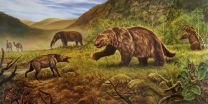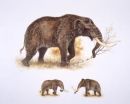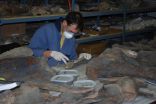(Press-News.org) Existing age estimates of American mastodon fossils indicate that these extinct relatives of elephants lived in the Arctic and Subarctic when the area was covered by ice caps--a chronology that is at odds with what scientists know about the massive animals' preferred habitat: forests and wetlands abundant with leafy food. In a paper published this week in the Proceedings of the National Academy of Sciences, an international team of researchers is revising fossil age estimates based on new radiocarbon dates and suggesting that the Arctic and Subarctic were only temporary homes to mastodons when the climate was warm. The new findings also indicate that mastodons suffered local extinction several tens of millennia before either human colonization--the earliest estimate of which is between 13,000 and 14,000 years ago--or the onset of climate changes at the end of the ice age about 10,000 years ago, when they were among 70 species of mammals to disappear in North America.
"Scientists have been trying to piece together information on these extinctions for decades," said Ross MacPhee, a curator in the Department of Mammalogy at the American Museum of Natural History and a co-author on the paper. "Was is the result of over-hunting by early people in North America? Was it the rapid global warming at the end of the ice age? Did all of these big mammals go out in one dramatic die-off, or were they paced over time and due to a complex set of factors?"
Over the course of the late Pleistocene, between about 10,000 and 125,000 years ago, the American mastodon (Mammut americanum) became widespread and occupied many parts of continental North America as well as peripheral locations like the tropics of Honduras and the Arctic coast of Alaska. Mastodons were browsing specialists that relied on woody plants and lived in coniferous or mixed woodlands with lowland swamps.
"Mastodon teeth were effective at stripping and crushing twigs, leaves, and stems from shrubs and trees. So it would seem unlikely that they were able to survive in the ice-covered regions of Alaska and Yukon during the last full-glacial period, as previous fossil dating has suggested," said Grant Zazula, a paleontologist in the Yukon Palaeontology Program and lead author on the new work.
The research team used two different types of precise radiocarbon dating on a collection of 36 fossil teeth and bones of American mastodons from Alaska and Yukon, the region known as eastern Beringia. The dating methods, performed at Oxford University and the University of California, Irvine, are designed to only target material from bone collagen, not accompanying "slop," including preparation varnish and glues that were used many years ago to strengthen the specimens.
All of the fossils were found to be older than previously thought, with most surpassing 50,000 years, the effective limit of radiocarbon dating. When taking mastodon habitat preferences and other ecological and geological information into account, the results indicate that mastodons probably only lived in the Arctic and Subarctic for a limited time around 125,000 years ago, when forests and wetlands were established and the temperatures were as warm as they are today.
"The residency of mastodons in the north did not last long," Zazula said. "The return to cold, dry glacial conditions along with the advance of continental glaciers around 75,000 years ago effectively wiped out their habitats. Mastodons disappeared from Beringia, and their populations became displaced to areas much farther to the south, where they ultimately suffered complete extinction about 10,000 years ago."
The work has several implications. Researchers know that giant ground sloths, American camels, and giant beavers made the migration as well, but they are still investigating what other groups of animals might have followed this course. The new report also suggests that humans could not have been involved in the local extinction of mastodons in the north 75,000 years ago as they had not yet crossed the Bering Isthmus from Asia.
"We're not saying that humans were uninvolved in the megafauna's last stand 10,000 years ago. But by that time, whatever the mastodon population was down to, their range had shrunken mostly to the Great Lakes region," MacPhee said. "That's a very different scenario from saying the human depredations caused universal loss of mastodons across their entire range within the space of a few hundred years, which is the conventional view."
INFORMATION:
Other authors on the paper include Jessica Metcalfe, University of British Columbia; Alberto Reyes, University of Alberta; Fiona Brock and Shweta Nalawade-Chavan, Oxford Radiocarbon Accelerator Unit; Patrick Drukenmiller, University of Alaska Museum and University of Alaska Fairbanks; Pamela Groves, Daniel Mann, and Michael Kunz, University of Alaska Fairbanks; C. Richard Harington, Canadian Museum of Nature; Gregory Hodgins, University of Arizona, Tucson; Fred Longstaffe, University of Western Ontario, London; H. Gregory McDonald, U.S. National Parks Service; and John Southon, University of California, Irvine.
Funding for this work was provided by the Bureau of Land Management Arctic Field Office. The Vuntut Gwitchin First Nation of Old Crow and the Yukon placer gold mining community provided support and assistance with the collection of ice age fossils from Yukon.
AMERICAN MUSEUM OF NATURAL HISTORY
The American Museum of Natural History, founded in 1869, is one of the world's preeminent scientific, educational, and cultural institutions. The Museum encompasses 45 permanent exhibition halls, including the Rose Center for Earth and Space and the Hayden Planetarium, as well as galleries for temporary exhibitions. It is home to the Theodore Roosevelt Memorial, New York State's official memorial to its 33rd governor and the nation's 26th president, and a tribute to Roosevelt's enduring legacy of conservation. The Museum's five active research divisions and three cross-disciplinary centers support approximately 200 scientists, whose work draws on a world-class permanent collection of more than 33 million specimens and artifacts, as well as specialized collections for frozen tissue and genomic and astrophysical data, and one of the largest natural history libraries in the world. Through its Richard Gilder Graduate School, it is the only American museum authorized to grant the Ph.D. degree. In 2012, the Museum began offering a pilot Master of Arts in Teaching program with a specialization in Earth science, which is the only non-university affiliated such program in the United States. Approximately 5 million visitors from around the world came to the Museum last year, and its exhibitions and Space Shows can be seen in venues on five continents. The Museum's website and collection of apps for mobile devices extend its collections, exhibitions, and educational programs to millions more beyond its walls. Visit amnh.org for more information.
Follow
Become a fan of the Museum on Facebook at facebook.com/naturalhistory, follow us on Instagram at @AMNH, Tumblr at amnhnyc or visit twitter.com/AMNH to follow us on Twitter.
RIVERSIDE, Calif. - Multiple sclerosis (MS), an autoimmune disease of the brain and spinal cord, affects about 2.3 million people worldwide (400,000 in the United States). Affecting more women than men, it can be seen at any age, although it is most commonly diagnosed between the ages of 20 and 40.
An unpredictable disease that disrupts the flow of information within the brain and between the brain and the body, MS is triggered when the immune system attacks the myelin sheath, the protective covering around the axons of nerve fibers. The "demyelination" that follows ...
CHAMPAIGN, Ill. -- The house mouse, stickleback fish and honey bee appear to have little in common, but at the genetic level these creatures respond in strikingly similar ways to danger, researchers report. When any of these animals confronts an intruder, the researchers found, many of the same genes and brain gene networks gear up or down in response.
This discovery, reported in the Proceedings of the National Academy of Sciences, suggests that distantly related organisms share some key genetic mechanisms that help them respond to threats, said University of Illinois ...
The rapid evolution of HIV, which has allowed the virus to develop resistance to patients' natural immunity, is at the same time slowing the virus's ability to cause AIDS, according to new research funded by the Wellcome Trust.
The study also indicates that people infected by HIV are likely to progress to AIDS more slowly - in other words the virus becomes less 'virulent' - because of widespread access to antiretroviral therapy (ART).
Both processes make an important contribution to the overall goal of the control and eradication of the HIV epidemic. In 2013, there ...
The most commonly used medications for osteoporosis worldwide, bisphosphonates, may also prevent certain kinds of lung, breast and colon cancers, according to two studies led by researchers at the Icahn School of Medicine at Mount Sinai and published today in the Proceedings of the National Academy of Sciences (PNAS).
Bisphosphonates had been associated by past studies with slowed tumor growth in some patients but not others, and the mechanism behind these patterns was unknown. In the studies published today, an international research team showed that bisphosphonates ...
Any science textbook will tell you we can't see infrared light. Like X-rays and radio waves, infrared light waves are outside the visual spectrum.
But an international team of researchers co-led by scientists at Washington University School of Medicine in St. Louis has found that under certain conditions, the retina can sense infrared light after all.
Using cells from the retinas of mice and people, and powerful lasers that emit pulses of infrared light, the researchers found that when laser light pulses rapidly, light-sensing cells in the retina sometimes get a double ...
INDIANAPOLIS and NEW BRUNSWICK, N.J. -- Imperceptible variations in movement patterns among individuals with autism spectrum disorder are important indicators of the severity of the disorder in children and adults, according to a report presented at the 2014 Society for Neuroscience annual meeting in November.
For the first time, researchers at Indiana University and Rutgers University report developing a quantitative way to assess these otherwise ignored variations in movement and link those variations to a diagnosis.
"This is the first time we have been able to explicitly ...
Two years ago, researchers at the U.S. Department of Energy's Joint BioEnergy Institute (JBEI) engineered Escherichia coli (E. coli) bacteria to convert glucose into significant quantities of methyl ketones, a class of chemical compounds primarily used for fragrances and flavors, but highly promising as clean, green and renewable blending agents for diesel fuel. Now, after further genetic modifications, they have managed to dramatically boost the E.coli's methyl ketone production 160-fold.
"We're encouraged that we could make such a large improvement in methyl ketone ...
In a remarkable collaborative effort between human and veterinary clinicians, a 29-year-old bottlenose dolphin recently underwent therapeutic bronchoscopy to treat airway narrowing, or stenosis, that was interfering with her breathing. The dolphin, a therapy animal for mentally and physically challenged children at Island Dolphin Care in Key Largo, Florida, is doing well one year after the procedure.
"Many of the medical treatments and procedures used in humans were developed and tested in animals, and many are used in the care of both," said lead author Andrew R. Haas, ...
MADISON, Wis. -- In 1997, IBM's Deep Blue computer beat chess wizard Garry Kasparov. This year, a computer system developed at the University of Wisconsin-Madison equaled or bested scientists at the complex task of extracting data from scientific publications and placing it in a database that catalogs the results of tens of thousands of individual studies.
"We demonstrated that the system was no worse than people on all the things we measured, and it was better in some categories," says Christopher Ré, who guided the software development for a project while a UW ...
MADISON, Wis. -- If Brad Singer knew for sure what was happening three miles under an odd-shaped lake in the Andes, he might be less eager to spend a good part of his career investigating a volcanic field that has erupted 36 times during the last 25,000 years. As he leads a large scientific team exploring a region in the Andes called Laguna del Maule, Singer hopes the area remains quiet.
But the primary reason to expend so much effort on this area boils down to one fact: The rate of uplift is among the highest ever observed by satellite measurement for a volcano that ...







